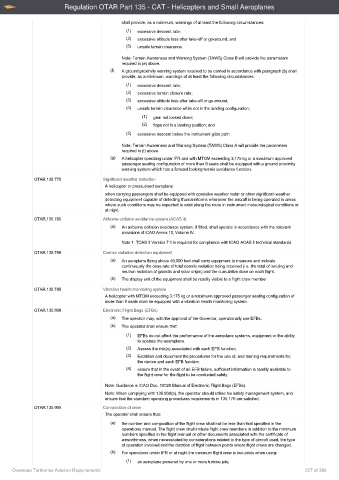Page 227 - Overseas Territories Aviation Requirements Consolidated - Total AOC
P. 227
Regulation OTAR Part 135 - CAT - Helicopters and Small Aeroplanes
shall provide, as a minimum, warnings of at least the following circumstances:
(1) excessive descent rate;
(2) excessive altitude loss after take-off or go-around; and
(3) unsafe terrain clearance.
Note: Terrain Awareness and Warning System (TAWS) Class B will provide the parameters
required in (e) above.
(f) A ground proximity warning system required to be carried in accordance with paragraph (b) shall
provide, as a minimum, warnings of at least the following circumstances:
(1) excessive descent rate;
(2) excessive terrain closure rate;
(3) excessive altitude loss after take-off or go-around;
(4) unsafe terrain clearance while not in the landing configuration;
(1) gear not locked down;
(2) flaps not in a landing position; and
(5) excessive descent below the instrument glide path.
Note: Terrain Awareness and Warning System (TAWS) Class A will provide the parameters
required in (f) above.
(g) A helicopter operating under IFR and with MTOM exceeding 3,175 kg or a maximum approved
passenger seating configuration of more than 9 seats shall be equipped with a ground proximity
warning system which has a forward looking terrain avoidance function.
OTAR.135.775 Significant weather detection
A helicopter or pressurised aeroplane:
when carrying passengers shall be equipped with operative weather radar or other significant-weather
detecting equipment capable of detecting thunderstorms whenever the aircraft is being operated in areas
where such conditions may be expected to exist along the route in instrument meteorological conditions or
at night.
OTAR.135.785 Airborne collision avoidance system (ACAS II)
(a) An airborne collision avoidance system, if fitted, shall operate in accordance with the relevant
provisions of ICAO Annex 10, Volume IV.
Note 1: TCAS II Version 7.1 is required for compliance with ICAO ACAS II technical standards.
OTAR.135.790 Cosmic radiation detection equipment
(a) An aeroplane flying above 49,000 feet shall carry equipment to measure and indicate
continuously the dose rate of total cosmic radiation being received (i.e. the total of ionizing and
neutron radiation of galactic and solar origin) and the cumulative dose on each flight.
(b) The display unit of the equipment shall be readily visible to a flight crew member.
OTAR.135.795 Vibration health monitoring system
A helicopter with MTOM exceeding 3,175 kg or a maximum approved passenger seating configuration of
more than 9 seats shall be equipped with a vibration health monitoring system.
OTAR.135.800 Electronic Flight Bags (EFBs)
(a) The operator may, with the approval of the Governor, operationally use EFBs.
(b) The operator shall ensure that:
(1) EFBs do not affect the performance of the aeroplane systems, equipment or the ability
to operate the aearoplane.
(2) Assess the risk(s) associated with each EFB function.
(3) Establish and document the procedures for the use of, and training requirements for,
the device and each EFB function.
(4) ensure that in the event of an EFB failure, sufficient information is readily available to
the flight crew for the flight to be conducted safely.
Note: Guidance is ICAO Doc. 10020 Manual of Electronic Flight Bags (EFBs).
Note: When complying with 135.800(b), the operator should utilise his safety management system, and
ensure that the standard operating procedures requirements in 135.170 are satisfied.
OTAR.135.905 Composition of crew
The operator shall ensure that:
(a) the number and composition of the flight crew shall not be less than that specified in the
operations manual. The flight crew shall include flight crew members in addition to the minimum
numbers specified in the flight manual or other documents associated with the certificate of
airworthiness, when necessitated by considerations related to the type of aircraft used, the type
of operation involved and the duration of flight between points where flight crews are changed.
(b) For operations under IFR or at night the minimum flight crew is two pilots when using:
(1) an aeroplane powered by one or more turbine jets;
Overseas Territories Aviation Requirements 227 of 386

